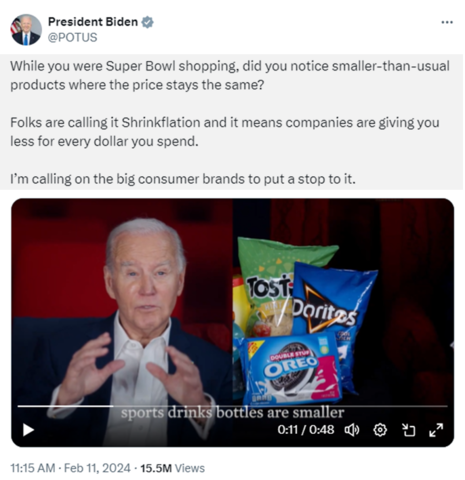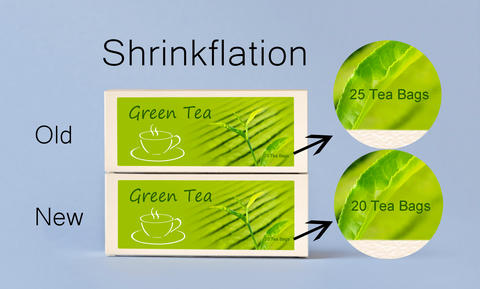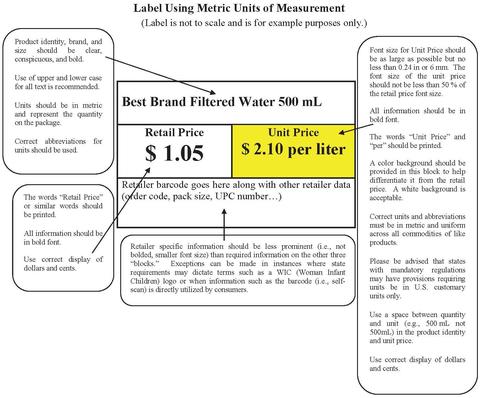Summary
"Shrinkflation" is now a common term to describe how consumer products are sold at the same price, but contents have been slightly reduced. Consumers can use an understanding of unit pricing for product value comparisons and make an informed decision on what they are purchasing. Retailers also benefit when unit price labeling best practices are implemented, which include improvements for ordering, inventory control, and pricing accuracy, which ultimately saves the retailer money from reduced labor costs. NIST OWM provides resources for both consumers and retailers, including NIST SP 1181, Unit Pricing Guide: A Best Practice Approach to Unit Pricing and A Guide to U.S. Retail Pricing Laws and Regulations.
Description
Many consumers across the U.S. are increasingly aware of the decreasing quantity for many of the products that they regularly purchase and consume. This concept is know as product downsizing or “shrinkflation”, a term used to describe how a consumer product is sold at the same price, but whose net contents have been reduced. Because it is difficult for consumers to monitor product quantity changes when shopping, how can they make the best purchasing decision when faced with changing package sizes?
Shrinkflation had a nationwide moment in the President's State of the Union 2024 address, and in particular detail on Superbowl Sunday this past February with President Biden making an appeal on X (formerly known as Twitter) for companies to put a stop to it. Quoting the President, “When buying snacks for the game, you might have noticed one thing: sports drink bottles are smaller, a bag of chips has fewer chips, but they’re still charging you just as much.”

This concept of shrinkflation (and its awareness raised by the President) was subsequently highlighted in news articles in CNN Business (February 11, 2024) and Packaging Digest (February 22, 2024), a trade journal for the packaging commercial industry. Last year, the U.S. Bureau of Labor Statistics published a comprehensive overview publication, “Getting less for the same price?” which demonstrated the general trends of a range of consumer items that have the highest instance of downsizing during the period of January 2015 to December 2021. Based on the Bureau of Labor Statistics analysis in 2023, approximately 30% of consumer goods have been downsized and likely affected by shrinkflation over the past 4 years (see summary within Table 1).

Table 1. Item categories with the largest effect of downsizing in 2019–2023, by percentage, results for January 2019–October 2023
Manufactures have two choices when they need to accommodate for increased production and transportation costs: 1) increase price or 2) downsize. Because consumers are sensitive to price changes, packers prefer to use downsizing as a method to account for changing costs. From the consumer perspective, the chief complaint about shrinkflation stems from its prevalence in the marketplace and the perceived intent to deceive the consumer of changes (i.e., changes to the net content of the products without price changes).

Figure 1. Package content reduction without changing the price of the product is known as shrinkflation or downsizing.
What Can a Consumer Do?
In the interest of marketplace equity, savvy consumers can use simple consumer math to calculate unit pricing and determine product values and make an informed value comparison purchasing decisions. The U.S. retail grocery industry reports that 78% of consumers use unit pricing when it is available. For example, 1.44 quarts (1.36 liters) of ice cream in a slightly smaller container are now commonly sold products in the grocery frozen section, compared with the 1.5 quarts (1.41 liters) of ice cream that was commonly found in stores just a few years back. Regular comments in popular culture also point to past times when the “half gallon” (i.e., 2 quarts) was the norm for ice cream products.
The pricing of goods based on the cost per unit of measure, commonly known as unit pricing, is the best tool a consumer has when shopping. Unit pricing labels typically display the product name and size, the price, the price per unit (e.g., how much you pay per gram, liter, or ounce), and other information. Unit pricing is most frequently displayed as a label or sign on a retail store shelf (paper or digital). Unit pricing can also be found when shopping online on e-commerce sites. Consumer Reports provides a short video explaining unit pricing to consumers.
A well-designed unit pricing label provides information to consumers with clear and unambiguous product price information. This enables the consumer to select the best quantity-price ratio and use that information to make an educated purchasing decision, especially when differentiating between the prices of similar products. See the series of retail store shelf labels in Figure 2 that are commonly encountered in the marketplace today. While not perfect, this series of labels does allow a consumer to make an informed choice regarding what to purchase that is irrespective of its "container" and based on a value comparison of inherent product characteristics. For example, in Figure 2, the product contains performance ingredients ("perf") or is certified as organic ("org").

Figure 2. Retail store shelf labels for packaged soil, each of which has consistent unit price labeling (per/by quart) displayed with descriptions and total price of the product.
Voluntary unit pricing has been in existence in the U.S. marketplace since the early 1970s and existing model unit pricing regulations can be found in NIST Handbook (HB) 130, Uniform Laws and Regulations. The Uniform Unit Pricing Regulation (UUPR) applies only when stores voluntarily provide unit pricing information. The UUPR has never included a mandatory provision. Currently, nineteen states and two territories have implemented unit pricing laws or regulations. Eleven of these jurisdictions have mandatory unit pricing provisions (e.g., Connecticut, Maryland, Massachusetts, New Hampshire, New Jersey, New York, Oregon, Puerto Rico, Rhode Island, Vermont, and the Virgin Islands). Thirty-four state jurisdictions do not have laws or regulations in place. NIST Handbook 130 currently permits retail stores to provide unit pricing in metric units. For additional information and a listing of state jurisdictions that adopt unit pricing laws and regulations, please refer to NIST Handbook 130, Chapter II (page 6).
Uniform Unit Pricing is Good for Retailers Too
Retailers also benefit when unit price labeling best practices are implemented, including improved ordering, inventory control, and pricing accuracy. Unit pricing eliminates the need for individual item pricing (i.e., little price tag stickers), which saves the retailer money from reduced labor costs. Unit price labels may also be used to display certain kinds of nutritional information, such as low-sodium or high-fiber foods, and promote special programs such as the U.S. Department of Agriculture’s Women, Infants and Children (WIC). Overall, unit pricing can provide the retailer a competitive advantage by offering a means of customer service and satisfaction, and improving the shopping experience.

Figure 3. NIST researchers recommend several information elements and organization best practices for unit price label design in NIST SP 1181.
NIST OWM published SP 1181, Unit Pricing Guide: A Best Practice Approach to Unit Pricing, which provides a best practice approach to ensure that unit price labels are easy to read, informative, and understandable. This guidance was the result of a two-year collaboration among U.S. industry and consumer groups. Retailers and governments are encouraged to use NIST SP 1181 to improve the accuracy and usability of unit pricing information offered in both retail stores and online to ensure uniformity across participating retailers and states.
Learn More Here
- Unit Pricing Helps You Save (Consumer Reports Video)
- The Unit Price Is Right, NIST Taking Measure Blog
- New Best Practices Guide Shows Unit Pricing Is a Great Deal
- NIST SP 1181, Unit Pricing Guide: A Best Practice Approach to Unit Pricing
- A Guide to U.S. Retail Pricing Laws and Regulations
- Packaging and Labeling
- Weights and Measures Week
Research
- Kachersky, K. Reduce Content or Raise Price? The Impact of Persuasion Knowledge and Unit Price Increase Tactics on Retailer and Product Brand Attitudes, J. of Retailing, Volume 87, Issue 4, 479-488 (2011).
- Yao, J., Oppewal, H. & Wang, D. Cheaper and smaller or more expensive and larger: how consumers respond to unit price increase tactics that simultaneously change product price and package size. J. of the Acad. Mark. Sci., Volume 48, 1075–1094 (2020).
In the News
- Remarks by President Biden and Members of the Competition Council Announcing New Actions to Lower Costs for Hardworking Families by Fighting Corporate Rip-offs (Video of entire comments on C-SPAN; March 5, 2024).
- Even Cookie Monster is complaining about the US economy now (CNN; March 4, 2024)
- Consumers are increasingly pushing back against price increases — and winning (AP Business News; February 25, 2024)
- Biden calls on snack companies to stop shrinkflation ahead of Super Bowl (CNN Business; February 11, 2024)

